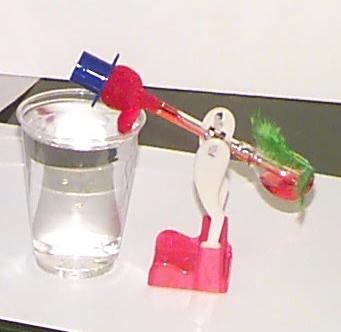
A hot object contains energy in the form of the random microscopic motions. It would be great if we could capture all this energy and use it for something -- polishing the floors, running the lawnmower, pumping water out of a well. But the Second Law has an important consequence here, because the energy in the hot object is shared among all of its parts, and to concentrate it and organize it into a visible motion is going the wrong way, thermodynamically.
We have compared temperature to the level of a lake several times. Trying to turn a temperature into usable energy is like trying to run a water wheel using a lake: it only works if there is a way to let water run out of the lake, to a lower level. Similarly, if we have two objects that are at different temperatures, we can produce some usable energy while letting heat flow from one to the other. The usable energy is more ordered, but this is offset by the gain in disorder (energy is shared between the two objects). We can't turn all of the energy of a hot object into useful energy, but we can turn some of it into useful energy.
One way to turn heat into motion -- the "Drinking Bird"
Here is a toy that you have probably met already.
This may not look like a device to produce useful energy, but you could imagine
harnessing a few thousand of them to make a baby-rocking
machine.
The Drinking Bird keeps itself in motion, despite
friction and all the other ways of sharing energy
with the rest of the universe -- how does it do this?
What is the fuel, and how is it converted into motion?

Let's study the drinking bird for a few minutes. You have one in your kit.
Refrigerators and heat pumps
The Second Law implies that energy can only move from hot to cold by itself. However, sometimes we want to make energy go the wrong way.
Refrigerators don't "make cold." They move energy from inside to the outside, making the ice cream colder while warming up the kitchen. Of course this can't happen by itself, but we can make it happen by expending some energy: you have to plug the refrigerator in.
The amount of energy that it takes to keep a
refrigerator running is small compared to the amount of
energy that is moved. This is the basic idea behind the
heat pump, which is a kind of home heating
system. It is exactly a refrigerator, but instead of removing
energy from the freezer compartment, it removes it from
your back yard; the energy ends up in your living room.
Using electrical energy to pump heat into your house is a
better idea than turning it directly into heat using a space
heater or running the electric stove, because you get more
heat for your electrical dollar. This is especially true when
it isn't very cold outside, because pumping heat up a small
temperature difference is like pumping water up a small
height -- it doesn't require much energy.
Check the box when you are done:
What have we learned about irreversibility?